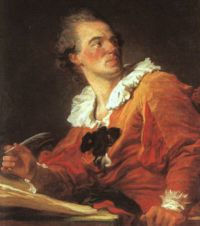(Grasse 1732 - Paris 1806)
The French painter Jean-Honoré Fragonard lived in Grasse till he was sixteen, the moment in which he began to work as clerk in a notary’s office because of the fact that his father was ruined. Finally, the notary persuaded Fragonard’s father to let Fragonard follow his artistic impulses. In 1748, he was accepted in the studio of François Boucher, who was by then at the height of his glory. Although the great artist admitted his obvious artistic faculties he did not want to train him till he was more prepared; therefore, he was addressed to the studio of Chardin, who tried to teach him the main techniques on painting.
Otherwise, during that time, Fragonard’s self-taught artistic education was based on his incursion through the streets, squares and buildings of Paris, where he took notes and tried to reproduce the most famous works he saw in the churches by heart. He was committed to being included among the disciples of the king’s painter. After studying during six months, he went again to the studio of Boucher, who this time accepted him willingly and having the feeling that Fragonard would be a brilliant heir to his voluptuous genius.
During three years, Fragonard was educated in Boucher’s school and there, undoubtedly, he acquired his taste for the voluptuous flesh-colored and the accent of sensuality that have earned him so many times the epithet of erotic painter. He triumphed in this subject.
Fragonard spent some years in the School of the Protected Students in the square of the Old Louvre. The artworks that date from that period are Basoche, Blind Man's Bluff, Lavement des Pieds, as well as many other works in which Fragonard tested his impatient inspiration.
The moment of leaving to Villa Mancini arrived. Fragonard went to say goodbye to Boucher, to who has been attributed by the anecdotal tradition the following recommendation that does not deserve to be omitted, as it suggests us the influence the master had over the disciple: “My dear Frago, you are going to see Michelangelo and Raphael, but let me tell you this in friendly confidence: if you take to that kind of painting seriously, you are lost!”.
At the beginning, Fragonard did not please Natoire, who was the director of the French Academy; but later, they became so close to, that Natoire asked for and got an extension of residence for the student. When the extension finished in 1761, he went back to Paris after being in Naples and Venice. In order to be accepted in the Salons, he painted Coresus and Callirhoe, an artwork where the great priest appears sacrificing his life to save Callirhoe (Louvre Museum). It obtained a tremendous success in the Salon of 1765. This work was a tour de force for Fragonard, who showed himself on this work as a good disciple. He provided the artwork with a lyricism of colours that was unusual to be found in works realized by young beginners. In the same Salon there were three more artworks, which were a landscape and two views of the East town, sent by Fragonard.
In 1769 Fragonard married Marie-Anne Gérard from Avignon. They had a daughter, Rosalia, and ten years later, in 1780 they had their son Alexandre-Évariste. Marie-Anne’s brother and sister, Marguerite and Enrique, also lived with them. Unfounded or not, the spicy anecdotal tradition says that Fragonard had an affair with his sister-in-law, who was more beautiful and spiritual than his wife.
The married life transformed Fragonard’s art and habits. The artworks Happy Fecundity, Visit to the Nursery, Maitresse d’École and La Bonne Mère belong to this period. Fragonard also excelled at painting miniatures.
The Revolution made Fragonard to flee France and to take refuge in Grasse (1793). He left Grasse and went back to Paris at the turn of the nineteenth century. In 1806, he died in Paris almost forgotten by everyone.


